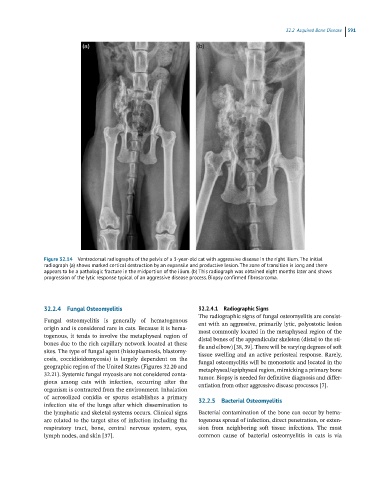Page 577 - Feline diagnostic imaging
P. 577
32.2 Accuired one Disease 591
Figure 32.14 Ventrodorsal radiographs of the pelvis of a 3-year-old cat with aggressive disease in the right ilium. The initial
radiograph (a) shows marked cortical destruction by an expansile and productive lesion. The zone of transition is long and there
appears to be a pathologic fracture in the midportion of the ilium. (b) This radiograph was obtained eight months later and shows
progression of the lytic response typical of an aggressive disease process. Biopsy confirmed fibrosarcoma.
32.2.4 Fungal Osteomyelitis 32.2.4.1 Radiographic Signs
The radiographic signs of fungal osteomyelitis are consist-
Fungal osteomyelitis is generally of hematogenous ent with an aggressive, primarily lytic, polyostotic lesion
origin and is considered rare in cats. Because it is hema- most commonly located in the metaphyseal region of the
togenous, it tends to involve the metaphyseal region of distal bones of the appendicular skeleton (distal to the sti-
bones due to the rich capillary network located at these fle and elbow) [38, 39]. There will be varying degrees of soft
sites. The type of fungal agent (histoplasmosis, blastomy- tissue swelling and an active periosteal response. Rarely,
cosis, coccidioidomycosis) is largely dependent on the fungal osteomyelitis will be monostotic and located in the
geographic region of the United States (Figures 32.20 and metaphyseal/epiphyseal region, mimicking a primary bone
32.21). Systemic fungal mycosis are not considered conta- tumor. Biopsy is needed for definitive diagnosis and differ-
gious among cats with infection, occurring after the entiation from other aggressive disease processes [7].
organism is contracted from the environment. Inhalation
of aerosolized conidia or spores establishes a primary 32.2.5 Bacterial Osteomyelitis
infection site of the lungs after which dissemination to
the lymphatic and skeletal systems occurs. Clinical signs Bacterial contamination of the bone can occur by hema-
are related to the target sites of infection including the togenous spread of infection, direct penetration, or exten-
respiratory tract, bone, central nervous system, eyes, sion from neighboring soft tissue infections. The most
lymph nodes, and skin [37]. common cause of bacterial osteomyelitis in cats is via

